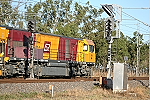|
The Moura Short Line was constructed to provide an efficient means of transporting coal from the Callide coal feilds
to the deepwater port of Gladstone in the early 1960's.
The Short Line tag is due to the fact that the previous line from the valley to Gladstone was via Mt Morgan and
Rockhampton and was well over 300km as compared to 150km of the current line.
The old line was built to a fairly light standard not suitable for the heavy haul trains that were to replace the
Beyer-Garratt steam locos and their 750 ton trains. The line was completed three months early and the first coal train was
run on 22 January 1968.
Trains of 4000 tons with three locos and 60 wagons were the norm and was the first regular use of heavy mainline diesels
operating in mutiples of three in Queensland. The new line was complemented by the construction of a new coal wharf at Barney
Point in Gladstone that can stockpile coal for shipping or can load directly from train to ship. In recent years the future
of this terminal was under threat because of residents concerns about coal dust from the terminals stockpile blowing over
the city but measures such as tree planting and wetting down the coal have proved successfull and the future seems bright
with a new balloon loop for unloading trains just completed.
At the time of its construction the line was unique due to its heavy earthworks, cuttings and fills that provide easy
grades for loaded trains. It has been recently upgraded with continious welded rail and concrete sleepers and now has an axle
limit of 25 ton and a speed limit of 80 kmh for loaded trains.
Signaling has also been improved as well as the crossing
loops and some level crossings.
Coal is king on this line but seasonal grain trains and regular freight trains can be found
on the line though I haven't been able to get a photo of a grain movement yet . The grain is mostly exported through the port
of Gladstone and the coal is used in power plants in Gladstone (Gladstone power station and Queensland Alumina Refinery) as
well as being exported as steaming or coking coal to Europe or Asia.
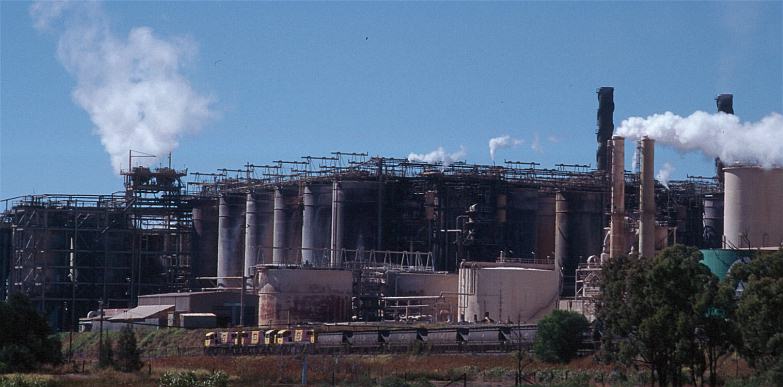
2139 + 2130 + 2152 arrive at Queensland Alumina Ltd with a load of steaming coal from Boundary Hill mine on the Moura
Line. The coal is used in the plants boilers to generate process steam for the refining of Bauxite into Alumina . The Alumina
(white powder) is then shipped to Aluminium Smelters around the world to be made into Aluminium. The coal is also used in
some of the ships that transport the Bauxite from Weipa to Gladstone in a modern version of a steam boiler and turbine.
The
locos are not needed to unload the train instead a cable haul system with a air compresser is used to slowly move the wagons
over the unloading pit and the compresser provides air for the bottom doors to open and close.
23/07/00
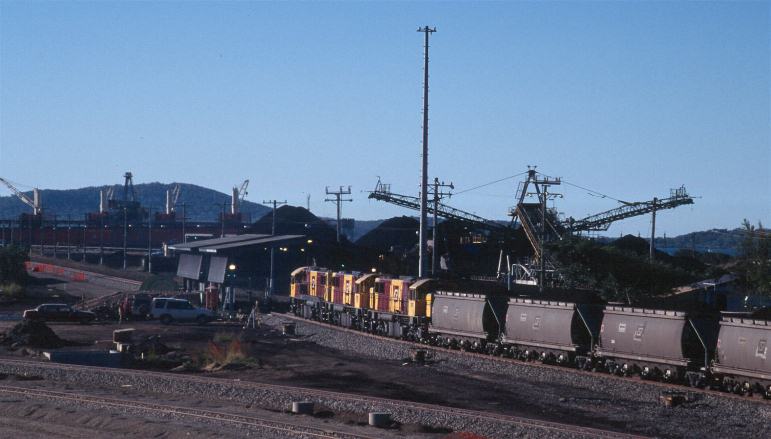
Three diesels on the rear of an electric coal train haul it through the Barney Point coal terminal on the new balloon
loop that still in the process of erecting the overhead wires . The previous method of unloading the trains was two four wheeled
wagons with air compressors mounted on them that ran side by side next to the power poles in the picture almost to the waters
edge. The haul wagons were linked on a continous cable and powered by an electric motor and gear system when the system needed
overhaul one of the terminals front end loaders was used to tow the train through the unloader. The old system was only designed
to unload trains of around 55 to 65 wagons long so when the electric trains started to unload coal at the terminal thay had
to be split in half to be unloaded then reassembeled with mid train locos and brake tested. The terminal has the advantage
of being able to stockpile the coal or load it straight onto the ship from the train which was the case with this train. You
may also notice that the wagons have boards welded to the top of the sides the crews call them "hungry boards" and allow the
wagons to carry more coal but not all the existing wagons in the fleet can be modified in this way.
15/07/00 4.20pm
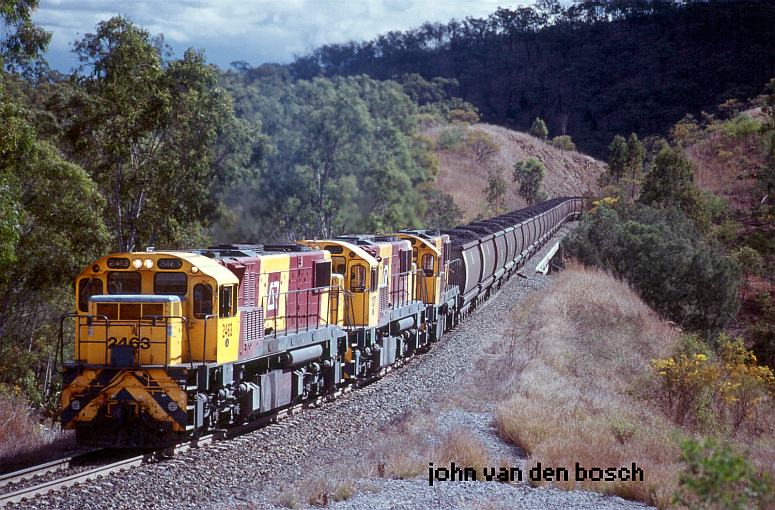
After listening to it for 15 minutes climbing the grade from Dumgree loop about 9 km away 2463 leads its train of 52
hoppers over the creek it has been following to climb to the grade to Mt Rainbow loop at the top of the Great Divideing Range
the train is about 100km from Gladstone.
1.45pm 30/8/99
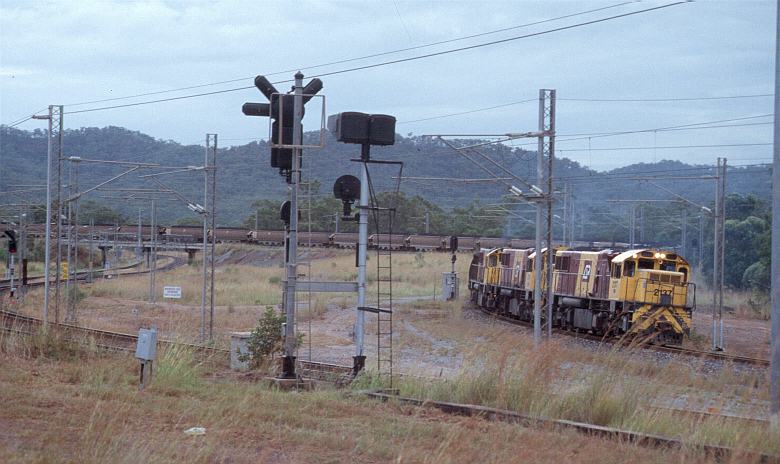
2137 leads its train over the Bylee flyover that allows trains to enter the arrival tracks at Callamondah yard from the
Moura line without blocking the busy North Coast Line just past the flyover the NCL crosses the Calliope River on two single
track bridges.
10/5/00
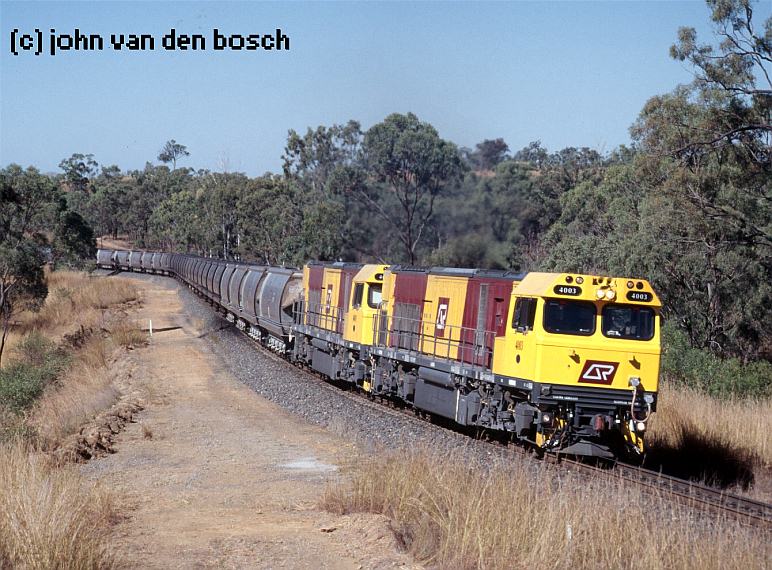
After unloading and provisioning then traversing the Gladstone Bypass to get to the Moura Line.Twin 4000 class locos power
up the short grade west of Stirrat after crossing with a loaded coal train holding the main.
1.50 pm Sunday 23/07/00

During October the combination of warm humid days and clear sky’s at night produces
some very foggy mornings and I was hoping to catch a train in one of these fogs. After a few false starts I got my wish on
the Moura Line near Calliope. The fog was so thick it wet the rails and prevented another train from leaving the loop at Stirrat
because the drivers couldn't see the signals.
This photo shows 4004 + 4009 with a load of coal from Moura stalled for
the third time on Stowe Bank about one hundred and fifty meters from the crest. The stall was a combination of wet rail and
the locos using all the sand in the small reservoir on the bogies.
After coming to a stop and applying the brakes the
crew went back to the second loco to retrieve its emergency sand. The sand was contained in two clear twenty-litre water containers.
The crew hauled them to the lead loco and poured them into the sand boxes, once completed the crew again gently applied the
power and with a bit of sand under their feet the locos pulled away and once over the crest the train rapidly accelerated
towards Gladstone arriving about 07.00.
It had taken a bit over and hour to climb the bank which shows just how much the
locos a burdened with to get the maximum amount of tonnage over the line with the least amount of equipment.
Click the photo to see the video at esnips.
06.30 Friday 09/10/04

An empty coal train headed by 2160 runs down Stowe Bank towards Graham the junction with the
Monto Line.
It crossed with the previous train at Byelle near Callamondah.
The blue and white striped triangle is a approach beacon used to alert crews that a lighted
approach signal is about to come into view.
9th October 2004 07.40
Videos
2163 and sister units on the Moura Line just west of Stirrat Loop heading to Gladstone with a load of coal.
A typical 4000 class coal set on the Moura Line consisting of two 4000 class locos and fivety-six 104 ton hoppers climbing
the bank at Stowe 26km from Gladstone.
|
